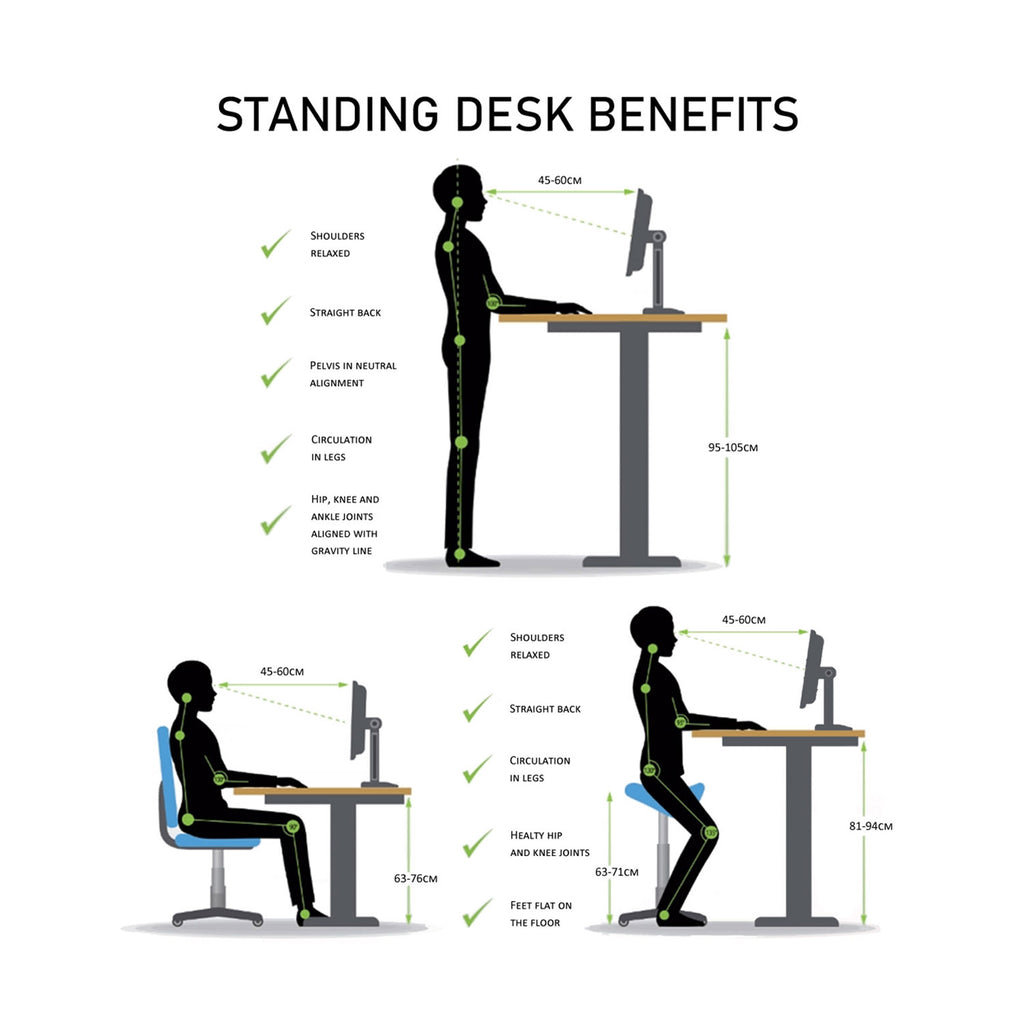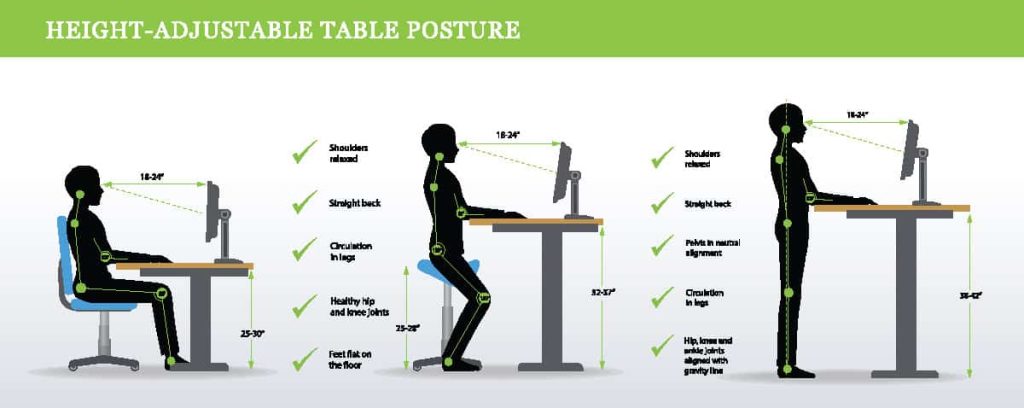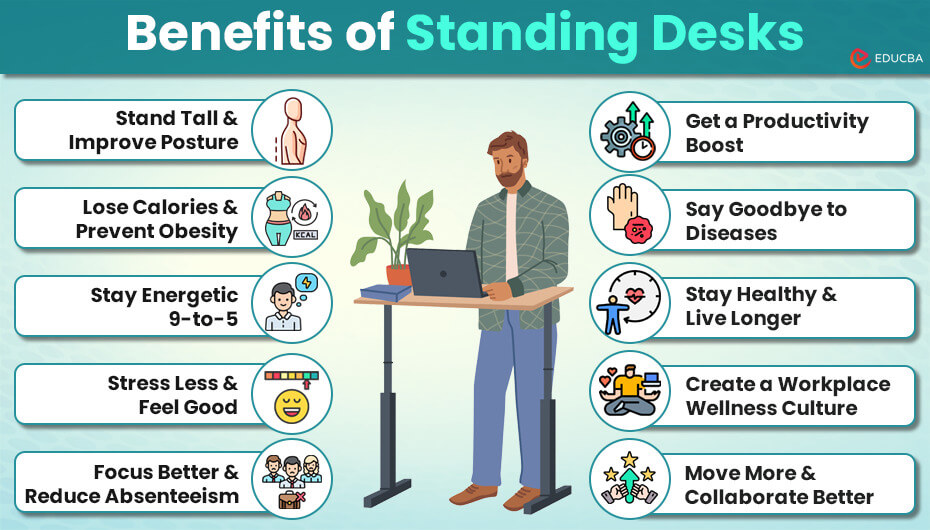Height Adjustable Desks, Standing Desk Converters, Standing Desks
The Benefits of Standing Desks
Are you tired of sitting all day at work? Consider the benefits of standing desks. Standing desks are gaining popularity as a healthier alternative to traditional office furniture. Not only do they help promote better posture and reduce the risks of sitting for prolonged periods, but they also increase energy levels and improve overall productivity. Standing desks offer a simple solution to combat the sedentary lifestyle that many of us have become accustomed to. So why not make a change and experience the countless benefits of incorporating a standing desk into your daily routine?

Improved Posture
Reduced risk of back and neck pain
When you use a standing desk, you naturally align your body in a more upright position. This helps to improve your posture and reduces the risk of developing back and neck pain. Sitting for long periods of time can cause you to slouch and put strain on your spine, leading to discomfort and potential long-term issues. By standing, you engage your core muscles and encourage proper spinal alignment, alleviating the pressure on your back and neck.
Increased core muscle strength
Using a standing desk activates your core muscles as they work to keep your body stable and balanced. Over time, this can lead to increased core strength. Strengthening your core muscles has a multitude of benefits, including better stability, improved balance, and reduced risk of injuries. Having a strong core also helps to support your spine and maintain good posture throughout the day.
Reduced Sedentary Behavior
Lower risk of obesity and weight gain
One of the main advantages of using a standing desk is that it helps reduce sedentary behavior. Sitting for prolonged periods of time has been linked to an increased risk of obesity and weight gain. When you stand, you burn more calories compared to sitting, which can contribute to maintaining a healthy weight. Standing also helps to keep your blood sugar levels stable and improves insulin sensitivity, which can further reduce the risk of developing obesity-related issues such as type 2 diabetes.
Improved cardiovascular health
Sitting for extended periods of time can have negative effects on your cardiovascular health. Research has shown that prolonged sitting is associated with an increased risk of heart disease. Using a standing desk encourages more movement throughout the day, stimulating blood flow and increasing oxygenation. This can help improve your cardiovascular health by reducing the risk of high blood pressure, cholesterol buildup, and other heart-related conditions.
Increased Energy and Productivity
Enhanced blood flow and oxygenation
When you stand, your muscles are more engaged and your heart is working slightly harder to pump blood throughout your body. This increased activity leads to enhanced blood flow and improved oxygenation. As a result, you may experience a boost in energy levels, making you feel more alert and focused. By improving blood circulation, standing desks can also contribute to faster muscle recovery during physical activity and reduce the likelihood of muscle fatigue.
Improved focus and concentration
Using a standing desk can help improve your cognitive abilities, including focus and concentration. Standing encourages better blood flow to the brain, which can enhance mental clarity and alertness. When you’re not constantly slouched over a desk, you may find it easier to stay engaged and focused on your work. This increased productivity can positively impact your overall performance and efficiency throughout the day.
Better Mood and Mental Health
Reduced feelings of stress and anxiety
Sitting for prolonged periods can lead to feelings of restlessness, stress, and anxiety. Standing, on the other hand, can trigger the release of endorphins, which are feel-good hormones that can help alleviate stress and elevate mood. Furthermore, the increase in blood flow to the brain promotes better oxygenation, aiding in mental relaxation and reducing feelings of anxiety. Using a standing desk can create a more positive and uplifting work environment, contributing to better mental health overall.
Increased sense of well-being
When you use a standing desk, you’re actively taking steps towards improving your health and well-being. Engaging in healthier habits can have a profound impact on your overall quality of life. By reducing sedentary behavior and promoting better posture and circulation, standing desks can provide a sense of accomplishment and satisfaction in making positive choices for your physical and mental health. This increased sense of well-being can translate into improved motivation, self-confidence, and overall happiness.

Potential Calorie Burn
Increased energy expenditure
Standing burns more calories compared to sitting. Although the difference may seem small, over time, it can contribute to weight management and overall calorie expenditure. Studies have shown that standing can burn approximately 50 more calories per hour compared to sitting. While it may not replace more intense forms of exercise, incorporating standing into your daily routine can be a simple way to increase your energy expenditure and support a healthy lifestyle.
Boosted metabolism
Using a standing desk can help boost your metabolism. When you stand, your body has to work harder to maintain balance and perform tasks, which revs up your metabolic rate. Increasing your metabolic rate can aid in weight management and assist in the breakdown of food, making proper digestion more efficient. By promoting a higher metabolic rate, standing desks can support overall metabolic health and help prevent issues related to a sluggish metabolism.
Lowered Risk of Chronic Diseases
Reduced risk of type 2 diabetes
Sitting for extended periods has been linked to an increased risk of developing type 2 diabetes. When you sit, your body’s ability to regulate blood sugar levels decreases. Using a standing desk instead can help keep your blood sugar levels more stable. Standing encourages movement and increases insulin sensitivity, assisting your body in processing glucose more effectively. By reducing the risk of developing type 2 diabetes, standing desks can help maintain overall metabolic health and promote a healthier lifestyle.
Lowered risk of certain cancers
Leading a sedentary lifestyle has been associated with a higher risk of certain types of cancer, including colon, breast, and endometrial cancer. By incorporating standing into your daily routine, you reduce the amount of time spent sitting, decreasing your overall sedentary behavior. This reduction in sedentary time can lower the risk of developing these cancers. While standing desks should not replace other preventative measures, they can serve as a positive step towards reducing your cancer risk and improving your long-term health.

Improved Circulation
Reduced risk of varicose veins
Sitting for extended periods can contribute to poor circulation and increase the risk of developing varicose veins. When you stand, your muscles naturally activate, aiding in the contraction of veins and promoting blood flow. By using a standing desk, you can reduce the likelihood of developing varicose veins and other circulation-related issues. Improved circulation also helps deliver oxygen and nutrients to your muscles, reducing muscle soreness and promoting better overall leg and foot health.
Enhanced leg and foot health
Standing encourages the use of your leg and foot muscles, which can improve their strength and overall health. When you sit for extended periods, these muscles can become weakened and stiff. By standing, you engage these muscles and promote better flexibility and blood circulation. This can help prevent issues such as muscle cramps, foot pain, and swelling. Incorporating a standing desk into your daily routine can contribute to better leg and foot health, reducing discomfort and improving your overall well-being.
Improved Digestion
Relief from digestive issues
Sitting for long periods of time can lead to sluggish digestion and contribute to digestive issues such as bloating and indigestion. When you stand, your digestive organs are in a more natural and upright position, allowing for better digestion and nutrient absorption. Standing after meals can help promote more efficient digestion and reduce the discomfort associated with digestive issues.
Prevention of constipation
Sedentary behavior can contribute to constipation and other bowel irregularities. By using a standing desk, you encourage more movement and reduce the time spent in a seated position. This increase in activity can help stimulate bowel movements, promoting regularity and reducing the risk of constipation. Incorporating standing into your work routine can aid in maintaining a healthy digestive system and prevent discomfort caused by constipation.

Increased Collaboration and Communication
Facilitation of spontaneous interactions
When you use a standing desk, you are more approachable and accessible to your colleagues. Standing allows for easier and more frequent interactions, encouraging spontaneous conversations and idea exchanges. This can foster a collaborative work environment and improve communication among team members. Standing desks promote a sense of openness and availability, making it easier for colleagues to approach you with questions, suggestions, or feedback.
Better teamwork and brainstorming
The increased collaboration and communication facilitated by standing desks can contribute to better teamwork and improved brainstorming sessions. When team members are more accessible and engaged, it becomes easier to bounce ideas off one another and build on each other’s thoughts. Standing promotes a more dynamic and interactive environment, encouraging team members to actively participate in discussions and contribute their unique perspectives. This can lead to more innovative ideas, better problem-solving, and ultimately, improved teamwork.
Customizable and Ergonomic Design
Adjustable height options
Standing desks come with adjustable height options, allowing you to customize the desk to suit your specific needs and preferences. This flexibility ensures that you can find the most comfortable working position, whether you prefer to sit, stand, or alternate between the two. Adjusting the height of the desk also allows you to maintain proper ergonomics, ensuring that your body is properly aligned and reducing the risk of strain or injuries. The ability to personalize your desk height contributes to overall comfort and promotes a healthier and more productive work environment.
Accommodates different body types
Standing desks are designed to accommodate different body types and heights. With adjustable height options, you can find the perfect fit for your specific physique, ensuring that you can work comfortably without straining your back, neck, or wrists. It is essential to have a workspace that supports your body and promotes good posture, regardless of your height or body type. Standing desks provide the flexibility needed to create a personalized and ergonomic setup that aligns with your individual needs.
In conclusion, incorporating a standing desk into your work routine can provide numerous benefits for your physical and mental health. The improved posture, reduced sedentary behavior, increased energy and productivity, better mood and mental health, potential calorie burn, lowered risk of chronic diseases, improved circulation, improved digestion, increased collaboration and communication, and customizable and ergonomic design all contribute to a healthier, more comfortable, and more efficient work environment. Consider integrating a standing desk into your workspace to enjoy these advantages and improve your overall well-being.



